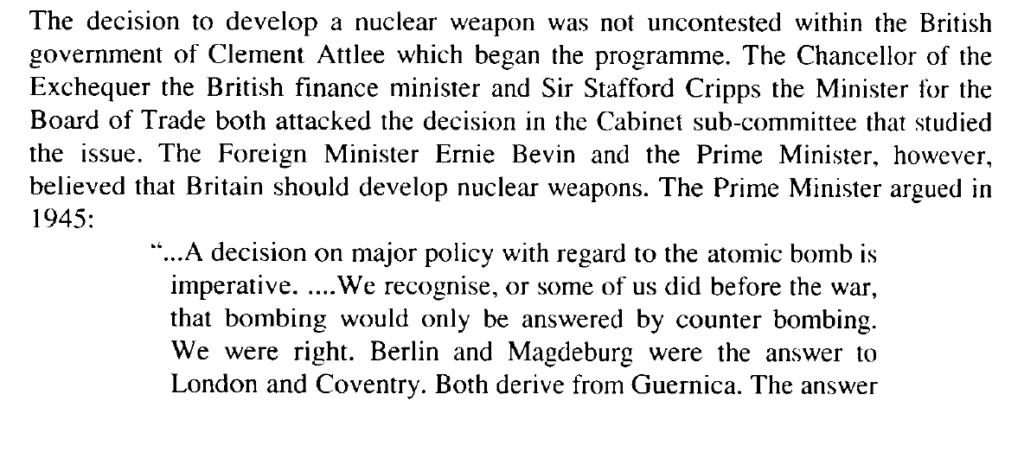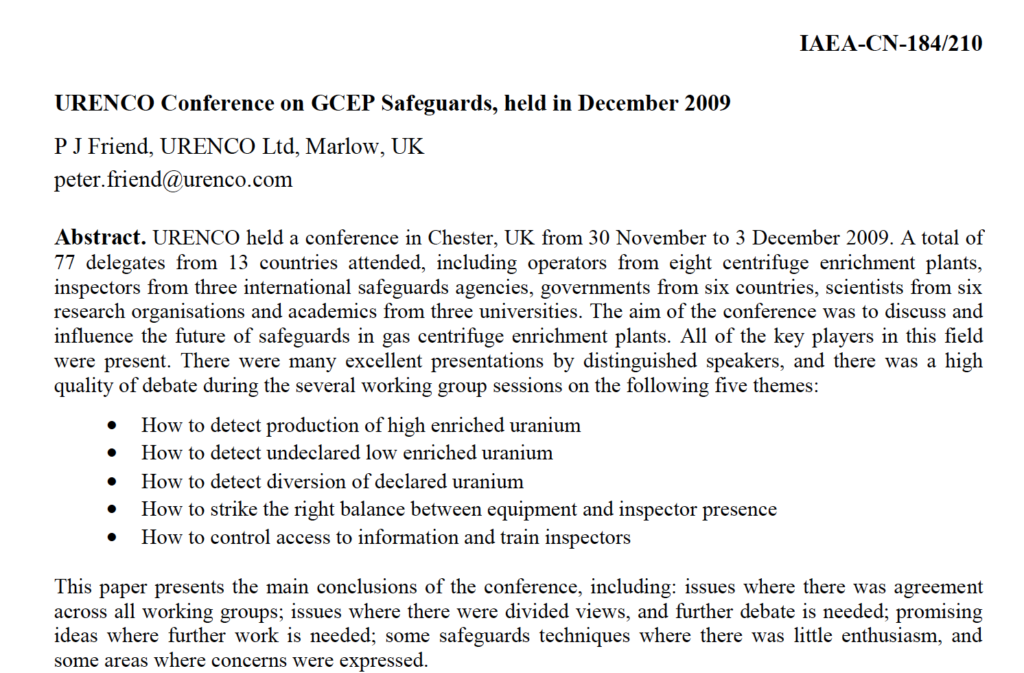This interview with Azad Jammu and Kashmir President Sardar Masood Khan doesn’t really have anything about nuclear weapons. But it does mention a connection I hadn’t made…. President Khan was Pakistan’s Chief Negotiator for the Nuclear Security Summit, as well as Chair of the 2006 BWC RevCon.
Monthly Archives: May 2020
Indian Army on Nuclear Weapons and Regional Security
OK, the title implies more depth than there is. But the Indian Army’s 2018 Land Warfare Doctrine has a couple of items about nuclear weapons and India’s security environment. Here’s one:
A concerted effort is being made by our adversaries to shrink the space for conventional wars, through prosecution of unconventional operations at the lower end of the spectrum and threats of early and irrational use of nuclear weapons at the other. While conventional war will remain central in the construct of the spectrum of operations, the Indian Army will continue to prosecute effective Counter Insurgency/ Counter Terrorism operations to ensure deterrence through punitive responses, against state sponsored proxy war.
I think the other points to operations in a post-detonation environment:
The Indian Army will continue to enhance our capability to fight in a Chemical, Biological, Radiological and Nuclear (CBRN) environment. Field formations/units will be equipped to prosecute operations through a Chemical, Biological, Radiological and Nuclear contaminated zone, to maintain tempo of operations.
DOE on U.S. Defense Uranium Needs
This report from the Nuclear Fuel Working Group provides some recent numbers on U.S., defense uranium needs, for those who are interested in that sort of thing:
Defense Needs: The U.S. has well-defined defense needs that also depend on a healthy nuclear fuel cycle in the long-term. There are currently two defense needs for uranium: low-enriched uranium is needed to produce tritium required for nuclear weapons, and highly- enriched uranium is used to fuel Navy nuclear reactors. Agreements with foreign suppliers prohibit the use of uranium for military purposes. DOE’s National Nuclear Security Administration is responsible for both these missions, and has sufficient stockpiles of unobligated uranium fuel to support tritium production until 2041 and Navy propulsion until the 2050’s. Ensuring a viable industry mitigates risk to future supply chains.
Pakistan Army 2020 Green Book
The Pakistan Army issued the 2020 edition of its Green Book not long ago. Although published by the army, the Green Book does have a disclaimer:
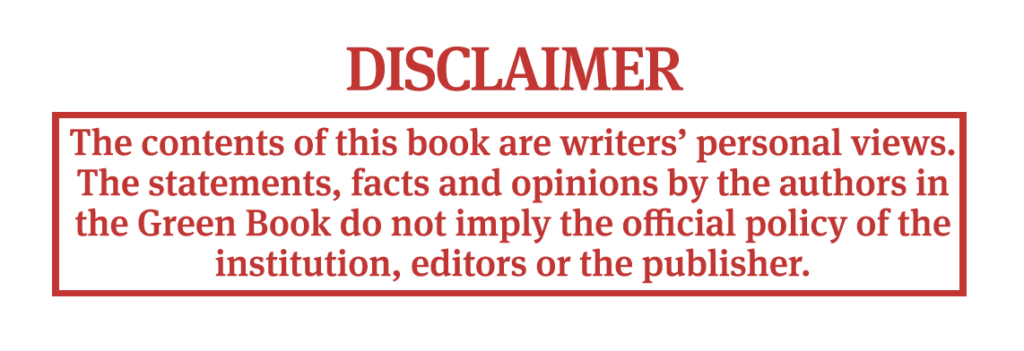
There’s a good amount of worthwhile material in here. If I recall correctly, the intro by Chief of Army Staff Javed Bajwa, NI (M), received some press attention, probably because of statements like this one:
Kashmir is a nuclear flashpoint and in total disregard to international norms, Mr. Modi has not only endangered the immediate neighbourhood, but has also raised the ante for the entire World.
Here’s the whole paragraph:
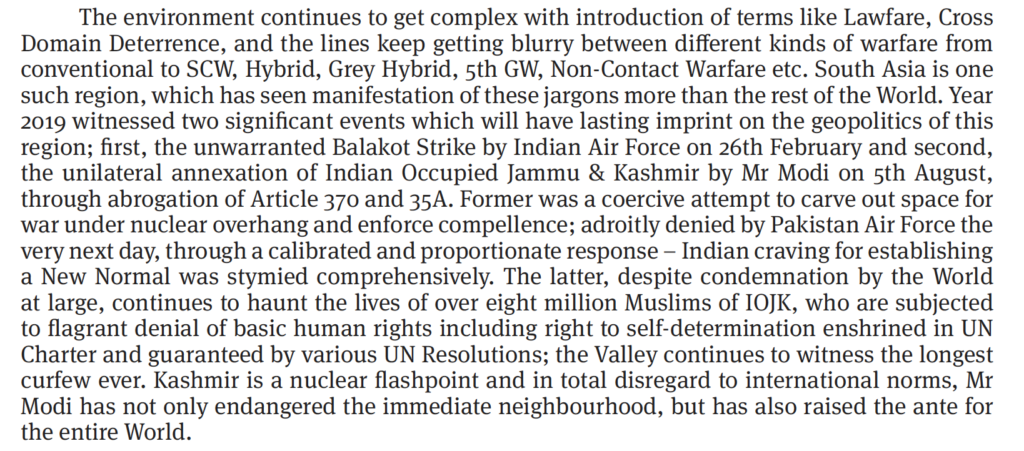
Global Zero Report Focus
A search of this report finds “Pakistan” twice and “India” and “Israel” 3 times each.
R Kadlec on Bio Threats
This wasn’t really the point of the piece, but this 5/4 WP piece about Robert Kadlec had this interesting quote from the man:
“Even though the war on terror was still going on, the resurgence of state actors like North Korea, like Iran, like China and Russia, were raising the bar in terms of the risks of WMD offenses against our interests and potentially our homeland,” Kadlec said.”
URENCO 2009 Paper
URENCO on Safeguards Trends, 2009 Edition
The 2009 URENCO report about which I posted the other day contains some claims about trends in safeguards implementation. Obviously, these observations may not currently apply.
Remote Monitoring:
| The physical presence of inspectors on nuclear sites is invaluable. Many ideas are being discussed for installing safeguards monitoring equipment in GCEP’s – for example to make better use of inspectorates’ resources – but there will always be benefits in people inspecting nuclear sites. These include the direct human interaction between operators and inspectorates to avoid misinterpretations, and the ability of intelligent inspectors to spot potential indicators of misuse of a GCEP. |
Equipment Replacing Inspectors:
Will more equipment reduce total costs? Some claimed that costs for safeguards verification would be reduced by partially replacing inspectors by monitoring equipment. Others doubted that that would be so: they thought that equipment developers always underestimate the lifetime cost of equipment – particularly when such equipment is still in the early phase of development. |
Various Other Safeguards Technologies:
| Cascade header enrichment monitor (CHEM).This instrument has been used to measure the U235 enrichment in cascade header pipes during limited frequency unannounced access (LFUA) inspections for many years in Japan and UK (although the instrument in use in UK became unreliable and was withdrawn in 2008). The instrument is used to confirm the presence of LEU. Whilst delegates could see that CHEM was useful for detecting HEU production, many thought that the instrument seemed cumbersome to use and that the effort was hardly worth the limited information gained from it. Nevertheless, others were in favour of upgrading the current instrument, to improve its usability, by replacing liquid nitrogen cooling by an electrically-powered cryostat. Current continuous enrichment monitor (CEMO). This instrument has been used to continuously to measure the U235 enrichment in 22 cascade product header pipes in UK for many years. Many thought that the instrument was too expensive, and that its old software made it difficult for inspectors to use. Most seemed to prefer a modified version of CEMO, which would be installed on a unit, rather than on each cascade Flow monitoring. An instrument could be developed to monitor the flow of UF6 gas in a pipe. Most were not interested in this idea, because they thought in unnecessary or too intrusive to monitor the flows of UF6 in pipes, or because the flows could be measured more easily by load cell monitoring. Radio frequency identification devices (RFID’s). In theory, a RFID could be fitted to each UF6 cylinder to track its location on a GCEP site. There are many different types of commercially available RFID’s, and these have been tested extensively in recent years – both in the laboratory and in the field. The conference generally felt that such a device held promise for the longer-term future, but that all of the current RFID’s had limitations which would prevent their routine use in the near term. |
Safeguards Fairness – URENCO 2009
A report titled URENCO Conference on GCEP Safeguards, held in December 2009, refers to the lack of safeguards on uranium enrichment plants in NWS. The fact is obvious, but operator-expressed concern about the situation’s unfairness was sufficient to warrant inclusion in the report.
There is unfairness due to a lack of a level playing field. Most of the uranium enrichment plants in nuclear weapons states are not subject to international safeguards – either because the state concerned has not made them available for safeguards verification under their voluntary offer safeguards agreement, or because IAEA has chosen not to safeguard them. As these plants constitute around three-quarters of the enrichment capacity in the world, some felt that this was rather unfair on those operators whose plants are safeguarded. A few thought that the whole concept of safeguards was undermined when so much of the world capacity for uranium enrichment was outside the scheme.
More on Clement Attlee and Nuclear Weapons
While writing this post, I thought about something I once wrote about Clement Attlee and the British nuclear weapons program. Embarrassingly, I forgot that the first post cites the same document which formed the basis for the second post.
Anyway, I cited this chapter excerpt in the previous post:
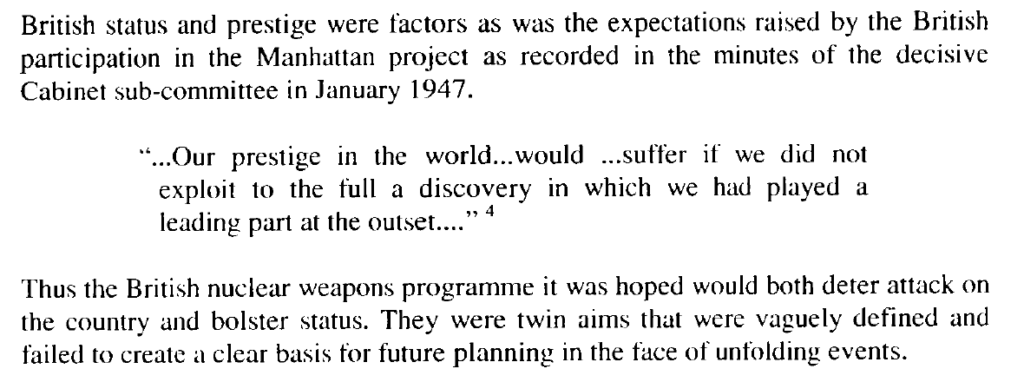
The above excerpt served as one account of the 1947 meeting of the secret committee which authorized the development of nuclear weapons. I wasn’t really discussing why the Brits decided to build the weapons. Obviously, the excerpt cites prestige. But the chapter also cites a more traditional deterrence rationale:
